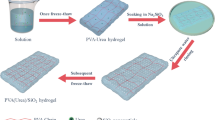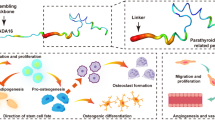Abstract
Combining synthetic polymer scaffolds with inorganic bioactive factors is widely used to promote the bioactivity and bone conductivity of bone tissue. However, except for the chemical composition of scaffold, the biomimetic structure also plays an important role in its application. In this study, we report the fabrication of polylactic acid/hydroxyapatite (PLA/HA) composite nanofibrous scaffolds via phase separation method to mimic the native extracellular matrix (ECM). The SEM analysis showed that the addition of HA dramatically impacted the morphology of the PLA matrix, which changed from 3D nanofibrous network structure to a disorderly micro-nanofibrous porous structure. At the same time, HA particles could be evenly dispersed at the end of the fiber. The FTIR and XRD demonstrated that there was not any chemical interaction between PLA and HA. Thermal analyses showed that HA could decrease the crystallization of PLA, but improve the thermal decomposition temperature of the composite scaffold. Moreover, water contact angle analysis of the PLA/HA composite scaffold demonstrated that the hydrophilicity increased with the addition of HA. Furthermore, apatite-formation ability tests confirmed that HA could not only more and faster induced the deposition of weak hydroxyapatite but also induced specific morphology of HA.








Similar content being viewed by others
References
Ji K, Wang YE, Wei QH, Zhang K, Jiang AG, Rao YW, et al. Application of 3D printing technology in bone tissue engineering. Bio-Des Manuf. 2018;3:203–10.
Tang D, Tare RS, Yang LY, Williams DF, Ou KL, Oreffo ROC. Biofabrication of bone tissue: approaches, challenges and translation for bone regeneration. Biomaterials. 2016;83:363–82.
Ye KQ, Liu DH, Kuang HZ, Cai JY, Chen WM, Sun BB, et al. Three-dimensional electrospun nanofibrous scaffolds displaying bone morphogenetic protein-2-derived peptides for the promotion of osteogenic differentiation of stem cells and bone regeneration. J Colloid Inter Sci. 2019;543:625–36.
Ou KL, Hosseinkhani H. Development of 3D in vitro technology for medical applications. Int J Mol Sci. 2014;15:17938–62.
Ku KC, Lee MW, Kuo SM, Yao CH, Chang SJ. Preparation and evaluation of collagen I/gellan gum/beta-TCP microspheres. Conf Proc IEEE Eng Med Biol Soc. 2013;2013:6667–770.
Popat KC, Eltgroth M, LaTempa TJ, Grimes CA, Desai TA. Decreased Staphylococcus epidermis adhesion and increased osteoblast functionality on antibiotic-loaded titania nanotubes. Biomaterials. 2007;28:4880–8.
Engel E, Michiardi A, Navarro M, Lacroix D, Planell JA. Nanotechnology in regenerative medicine: the materials side. Trends Biotechnol. 2008;26:39–47.
Murugan R, Ramakrishna S. Design strategies of tissue engineering scaffolds with controlled fiber orientation. Tissue Eng. 2007;13:1845–66.
Xu T, Yao QQ, Miszuk JM, Sanyour HJ, Hong ZK, Sun HL, et al. Tailoring weight ratio of PCL/PLA in electrospun three-dimensional nanofibrou scaffolds and the effect on osteogenic differentiation of stem cells. Colloid Surf B. 2018;171:31–9.
Wang XJ, Song GJ, Lou T. Fabrication and characterization of nano composite scaffold of poly(L-lactic acid)/hydroxyapatite. J Mater Sci. 2010;21:183–8.
Wutticharoenmongkol P, Pavasant P, Supaphol P. Osteoblastic phenotype expression of MC3T3-E1 cultured on electrospun polycaprolactone fiber mats filled with hydroxyapatite nanoparticles. Biomacromolecules. 2007;8:2602–10.
Schnell E, Klinkhammer K, Balzer S, Brook G, Klee D, Dalton P, et al. Guidance of glial cell migration and axonal growth on electrospun nanofibers of poly-ecaprolactone and a collagen/poly-e-caprolactone blend. Biomaterials. 2007;28:3012–25.
Nam J, Huang Y, Agarwal S, Lannutti J. Improved cellular infiltration in electrospun fiber via engineered porosity. Tissue Eng. 2007;13:2249–57.
Yao QQ, Cosme JGL, Xu T, Miszuk JM, Picciani PHS, Fong H, et al. Three dimensional electrospun PCL/PLA blend nanofibrous scaffolds with significantly improved stem cells osteogenic differentiation and cranial bone formation. Biomaterials. 2017;115:115–27.
Wang XF, Ding B, Li BY. Biomimetic electrospun nanofibrous structures for tissue engineering. Mater Tod. 2013;16:229–41.
Blakeney BA, Tambralli A, Anderson JM, Andukuri A, Lim DJ, Dean DR, et al. Cell infiltration and growth in a low density, uncompressed three-dimensional electrospun nanofibrous scaffold. Biomaterials. 2011;32:1583–90.
Liu XH, Jin XB, Ma PX. Nanofibrous hollow microspheres self-assembled from star-shaped polymers as injectable cell carriers for knee repair. Nat Mater. 2011;10:398–406.
Conoscenti G, Schneider T, Stoelzel K, Pavia FC, Brucato V, Goegele C, et al. PLLA scaffolds produced by thermally induced phase separation (TIPS) allow human chondrocyte growth and extracellular matrix formation dependent on pore size. Mat Sci Eng C. 2017;80:449–59.
Xu T, Yang HY, Yang DZ, Yu ZZ. Polylactic acid nanofiber scaffold decorated with chitosan islandlike topography for bone tissue engineering. Appl Mater Interfaces. 2017;9:21094–104.
Valente TMA, Silva DM, Gones PS, Fernandes MH, Santos JD, Sencadas V. Effect of sterization methods on electrospun poly(lactic acid) (PLA) fiber alignment for biomedical applications. Appl Mater Interfaces. 2016;8:3241–9.
Kumbar SG, Nukavarapu SP, James R, Nair LS, Laurencin CT. Electrospun poly (lactic acid-co-glycolic acid) scaffolds for skin tissue engineering. Biomaterials. 2008;29:4100–7.
Zhou PY, Cheng XS, Xia Y, Wang PF, Zou KD, Xu SG, et al. Organic/inorganic composite membranes based on poly(l-lactic-co-glycolic acid) and mesoporous silica for effectivebone tissue engineering. Appl Mater Interfaces. 2014;6:20895–903.
Xu T, Miszuk JM, Zhao Y, Sun HL, Fong H. Electrospun polycaprolactone 3D nanofibrous scaffold with interconnected and hierarchically structured pores for bone tissue engineering. Adv Health Mater. 2015;4:2238–46.
Shalumon KT, Anulekha KH, Girish CM, Prasanth R, Nair SV, Jayakumar R. Single step electrospinning of chitosan/poly(caprolactone) nanofibers using formic acid/acetone solvent mixture. Carbohyd Polym. 2010;80:413–9.
Heidari-Keshel S, Ahmadian M, Biazar E, Gazmeh A, Rabiei M, Adibi M, et al. Surface modification of poly hydroxybutyrate (PHB) nanofibrous mat by collagen protein and its cellular study. Mater Technol. 2016;31:799–805.
Grande D, Ramier J, Versaceet DL, Renard E, Langlois V. Design of functionalized biodegradable PHA-based electrospun scaffolds meant for tissue engineering applications. N Biotechnol. 2017;37:129–37.
Rezk AI, Mousa HM, Lee J, Park CH, Kim CS. Composite PCL/HA/simvastatin electrospun nanofifiber coating on biodegradable Mg alloy for orthopedic implant application. Technol Res. 2019;16:477–89.
Hassan MI, Sultana N, Hamdan S. Bioactivity assessment of poly(-caprolactone)/hydroxyapatite electrospun fibers for bone tissue engineering application. J Nanomater. 2014;2014:1–6.
Heydari Z, Kalhori DM, Afarani MS. Engineered electrospun polycaprolactone (PCL)/octacalcium phosphate (OCP) scaffffold for bone tissue engineering. Mater Sci Eng C. 2017;81:127–32.
Verma D, Katti K, Katti D. Bioactivity in in situ hydroxyapatite-polycaprolactone composites. J Biomed Mat Res A. 2006;78A:772–80.
Nguyen NK, Hoai TT, Viet PH. Biomimetic scaffolds based on hydroxyapatite nanorod/poly(d,l) lactic acid with their corresponding apatite-forming capability and biocompatibility for bone-tissue engineering. Colloid Surf B. 2015;128:506–14.
Abdal-hay A, Vanegas P, Hamdy AS, Engel FB, Lim JH. Preparation and characterization of vertically arrayed hydroxyapatite nanoplates on electrospun nanofifibers for bone tissue engineering. Chem Eng J. 2014;254:612–22.
Ribas RG, Schatkoski VM, Thaís Larissa do Amaral Montanheiro, BRCD Menezes, Stegemann C, DMG Leite, et al. Current advances in bone tissue engineering concerning ceramic and bioglass scaffolds: a review. Ceram Int. 2019;45:21051–61.
Wei GB, Ma PX. Structure and properties of nano-hydroxyapatite/polymer composite scaffolds for bone tissue engineering. Biomaterials. 2004;25:4749–57.
Sessini V, Navarro-Baena I, Arrieta MP, Dominici F, López D, Torre L, et al. Effect of the addition of polyester-grafted-cellulose nanocrystals on the shape memory properties of biodegradable PLA/PCL nanocomposites. Polym Degrad Stabil. 2018;152:126–38.
Woodard LN, Grunlan MA. Hydrolytic degradation of PCL-PLLA semi-IPNs exhibiting rapid, tunable degradation. ACS Biomater Sci Eng. 2018;5:498–508.
Liu SQ, He ZH, Xu GJ, Xiao XF. Fabrication of polycaprolactone nanofibrous scaffolds by facile phase separation approach. Mat Sci Eng C. 2014;44:201–8.
Ma PX. Biomimetic materials for tissue engineering. Adv Drug Deliv Rev. 2008;60:184–98.
Zhang JY, Ma SQ, Liu ZH, Geng HJ, Lu X, Zhang X, et al. Guided bone regeneration with asymmetric collagen-chitosan membranes containing aspirin-loaded chitosan nanoparticles. Int J Nanomed. 2017;12:8855–66.
Li XY, Yang Q, Ouyang J, Yang HM, Chang S. Chitosan modified halloysite nanotubes as emerging porous microspheres for drug carrier. Appl Clay Sci. 2016;126:306–12.
Ma PX, Zhang R. Synthetic nano-scale fibrous extracellular matrix. J Biomed Mater Res. 1999;46:60–72.
Francesco CP, Gioacchino C, Silvia G, Vincenzo LC, Giulio G, Valerio B. Preparation, characterization and in vitro test of composites poly-lactic acid/hydroxyapatite scaffolds for bone tissue engineering. Biomac. 2018;119:945–53.
Zhao XY, Han Y, Li WJ, Cai B, Gao H, Feng W, et al. BMP-2 immobilized PLGA/hydroxyapatite fifibrous scaffold via polydopamine stimulates osteoblast growth. Mater Sci Eng C. 2017;78:658–66.
Chen CC, Chueh JY, Tseng H, Huang HM, Lee SY. Preparation and characterization of biodegradable pla polymeric blends. Biomaterials. 2003;24:1167–73.
Wei XP, Luo YL, Xu F, Chen YS. Sensitive conductive polymer composites based on polylactic acid filled with multiwalled carbon nanotubes for chemical vapor sensing. Synth Met. 2016;215:216–22.
Zhou YH, Lei L, Yang B, Li JB, Ren J. Preparation and characterization of polylactic acid (PLA) carbon nanotube nanocomposites. Polym Test. 2018;68:34–8.
Apalangya VA, Rangari VK, Tiimob BJ, Jeelani S, Samuel T. Eggshell based nano-engineered hydroxyapatite and poly(lactic) acid electrospun fibers as potential tissue scaffold. Inter J Biomater. 2019;2019:6762575.
Yao CL, Zhu JM, Xie AJ, Shen YH, Li HY, Zheng B, et al. Graphene oxide and creatine phosphate disodium dual template-directed synthesis of GO/ hydroxyapatite and its application in drug delivery. Mater Sci Eng C. 2017;73:709–15.
Locardi B, Pazzaglia UE, Gabbi C, Profilo B. Thermal behaviour of hydroxyapatite intended for medical applications. Biomaterials.1993;14:437–41.
Rajzer I, Menaszek E, Kwiatkowski R, Chrzanowski W. Bioactive nanocomposite PLDL/nano-hydroxyapatite electrospun membranes for bone tissue engineering. J Mater Sci Mater Med. 2014;25:1239–47.
Rakmae S, Ruksakulpiwat Y, Sutapun W, Suppakarn N. Physical properties and cytotoxicity of surface-modified bovine bone-based hydroxyapatite/poly (lactic acid) composites. J Compos Mater. 2011;45:1259–69.
Kim CH, Khil MS, Kim HY, Lee HU, Jahng KY. An improved hydrophilicity via electrospinning for enhanced cell attachment and proliferation. J Biomed Mater Res B. 2005;78:283–90.
Unnithan AR, Sasikala ARK, Park CH, Kim CS. A unique scaffold for bone tissue engineering: an osteogenic combination of graphene oxide-hyaluronic acid-chitosan with simvastatin. J Ind Eng Chem. 2016;46:182–91.
Acknowledgements
Project supported by the Natural Science Foundation of Fujian Province (No. 2018J05092, 2019J01829) and by Fujian Functional Materials Industry Service-oriented Manufacturing Public Service Platform (Grant No. [2018] 236).
Author information
Authors and Affiliations
Corresponding author
Ethics declarations
Conflict of interest
The authors declare that they have no conflict of interest.
Additional information
Publisher’s note Springer Nature remains neutral with regard to jurisdictional claims in published maps and institutional affiliations.
Supplementary information
Rights and permissions
About this article
Cite this article
Liu, S., Zheng, Y., Liu, R. et al. Preparation and characterization of a novel polylactic acid/hydroxyapatite composite scaffold with biomimetic micro-nanofibrous porous structure. J Mater Sci: Mater Med 31, 74 (2020). https://doi.org/10.1007/s10856-020-06415-4
Received:
Accepted:
Published:
DOI: https://doi.org/10.1007/s10856-020-06415-4




